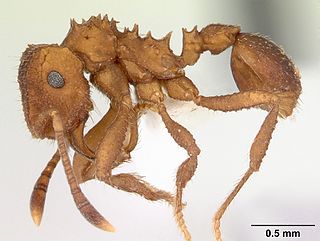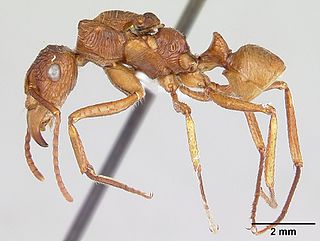
Ants are eusocial insects of the family Formicidae and, along with the related wasps and bees, belong to the order Hymenoptera. Ants evolved from vespoid wasp ancestors in the Cretaceous period. More than 13,800 of an estimated total of 22,000 species have been classified. They are easily identified by their geniculate (elbowed) antennae and the distinctive node-like structure that forms their slender waists.

In evolutionary biology, sympatric speciation is the evolution of a new species from a surviving ancestral species while both continue to inhabit the same geographic region. In evolutionary biology and biogeography, sympatric and sympatry are terms referring to organisms whose ranges overlap so that they occur together at least in some places. If these organisms are closely related, such a distribution may be the result of sympatric speciation. Etymologically, sympatry is derived from Greek συν (sun-) 'together', and πατρίς (patrís) 'fatherland'. The term was coined by Edward Bagnall Poulton in 1904, who explains the derivation.

Myrmica rubra, also known as the common red ant or erroneously the European fire ant, is a species of ant of the genus Myrmica, found all over Europe and is now invasive in some parts of North America and Asia. It is mainly red in colour, with slightly darker pigmentation on the head. These ants live under stones and fallen trees, and in soil. They are aggressive, often attacking rather than running away, and are equipped with a stinger, though they lack the ability to spray formic acid like the genus Formica.

Fungus-growing ants comprise all the known fungus-growing ant species participating in ant–fungus mutualism. They are known for cutting grasses and leaves, carrying them to their colonies' nests, and using them to grow fungus on which they later feed.

In biology, two related species or populations are considered sympatric when they exist in the same geographic area and thus frequently encounter one another. An initially interbreeding population that splits into two or more distinct species sharing a common range exemplifies sympatric speciation. Such speciation may be a product of reproductive isolation – which prevents hybrid offspring from being viable or able to reproduce, thereby reducing gene flow – that results in genetic divergence. Sympatric speciation may, but need not, arise through secondary contact, which refers to speciation or divergence in allopatry followed by range expansions leading to an area of sympatry. Sympatric species or taxa in secondary contact may or may not interbreed.
Megalomyrmex symmetochus is a species of ant in the subfamily Myrmicinae. It is native to Panama. This ant is also known as the parasitic guest ant.
Myrmecia inquilina is a species of ant endemic to Australia in the subfamily Myrmeciinae, first discovered in 1955 and described by Athol Douglas and William Brown Jr. in 1959. These ants are large, measuring 21.4 millimetres (0.84 in). During the time of its discovery, Douglas and Brown announced M. inquilina as the first social parasite among the primitive subfamilies, and today it is one of the two known Myrmecia species to have no worker caste. Two host species are known, Myrmecia nigriceps and Myrmecia vindex. Aggression between M. inquilina and its host species does not occur, and colonies may only produce M. inquilina brood months after the inquiline queens begin to lay their eggs. Queens eat the colony brood or trophic eggs, and other Myrmecia species may kill M. inquilina queens if they reject them. Due to its restricted distribution and threats to its habitat, the ant is "vulnerable" according to the IUCN Red List.

Rossomyrmex is a genus of slave-making ant in the subfamily Formicinae. The genus consists of four species, each with a single host from the genus Proformica, and has a very wide range of distribution from China to southeastern Spain, from huge extended plains to the top of high mountains.

Formica sanguinea, or blood-red ant, is a species of facultative slave-maker ant in the genus Formica characterized by the ability to secrete formic acid. It ranges from Central and Northern Europe through Russia to Japan, China, the Korean Peninsula, Africa and also the United States. This species is coloured red and black with workers up to 7 mm long.

Mycocepurus smithii is a species of fungus-growing ant from Latin America. This species is widely distributed geographically and can be found from Mexico in the north to Argentina in the south, as well as on some Caribbean Islands. It lives in a variety of forested habitats and associated open areas. Two studies published in 2009 demonstrated that some populations of the species consist exclusively of females which reproduce via thelytokous parthenogenesis. A detailed study found evidence of sexual reproduction in some populations in the Brazilian Amazon. Accordingly, M. smithii consists of a mosaic of sexually and asexually reproducing populations. In asexual populations all ants in a single colony are female clones of the queen. Inside the colony, the ants cultivate a garden of fungus grown with pieces of dead vegetable matter, dead insects, and insect droppings.

Mycocepurus is a Neotropical genus of fungus-growing ants in the subfamily Myrmicinae. The genus is known from Mexico, south to Brazil and Argentina. Like other attines, they primarily grow fungi of the tribe Leucocoprini. They use many different substrates for growing their fungi, from dry leaves and caterpillar dung to fruit matter. One of its species, Mycocepurus smithii, which lives in South America, reproduces by cloning – all ants in a colony are clones of the queen. M. castrator is a parasite of M. goeldii.

Ectatomma parasiticum is a species of ant in the subfamily Ectatomminae. Known from Mexico, the species is a social parasite of the related species Ectatomma tuberculatum. It is the only parasitic species described in the Ectatomminae subfamily, and among the rare inquilines from the tropics.

Cyphomyrmex is a genus of fungus-growing ants found primarily in South and Central America. However, some species do come up to the southern portion of North America. They grow a variety of fungi in the tribe Leucocoprineae. Most fungal gardens are grown in small nodules, some species to cultivate entire mycelium, though. Colonies are monogynous and are relatively small with about 100 workers on average.

Dolichovespula adulterina is a species of parasitic social wasp found in the Palearctic region. D. adulterina feeds on a variety of foods, including insects, spiders, arthropods, meat, molluscs, fruit, nectar, and larval secretions. D. adulterina was formerly considered to be synonymous with D. arctica from the Holarctic region, but more recent research indicates that D. arctica is a separate species.

Slave-making ants or slaver ants are brood parasites that capture broods of other ant species to increase the worker force of their colony. After emerging in the slave-maker nest, slave workers work as if they were in their own colony, while parasite workers only concentrate on replenishing the labor force from neighboring host nests, a process called slave raiding.
Cyatta is a genus of ant in the subfamily Myrmicinae containing the single species Cyatta abscondita. It is considered the most recent ancestor of all fungus-farming ants and a living fossil.

Polistes biglumis is a species of social wasp within Polistes, the most common genus of paper wasp. It is distinguished mainly by its tendency to reside in montane climates in meadows or alpine areas. Selection pressure from the wasp's environment has led to several idiosyncrasies of its behavior and lifecycle with respect to its relative species in the genus Polistes. It alone among paper wasps is often polyandrous. In addition, it has a truncated nesting season that gives rise to unique competitive dynamics among females of the species. P. biglumis wasps use an odor-based recognition system that is the basis for all wasp-to-wasp interaction of the species. The wasp's lifecycle is highly intertwined with that of Polistes atrimandibularis, an obligate social parasite wasp that frequently invades the combs of P. biglumis wasps.

Polistes semenowi is a species of paper wasp in the genus Polistes that is found in southeastern and southern central Europe, as well as central Asia, and was until 2017 erroneously known by the name Polistes sulcifer, while a different species was incorrectly believed to represent P. semenowi. It is one of only four known Polistes obligate social parasites, sometimes referred to as "cuckoo paper wasps", and its host is the congeneric species Polistes dominula. As an obligate social parasite, this species has lost the ability to build nests, and relies on the host workers to raise its brood. P. semenowi females use brute force, followed by chemical mimicry in order to successfully usurp a host nest and take over as the queen.

Mycocepurus goeldii is a species of ant in the genus Mycocepurus.

Temnothorax corsicus is a socially parasitic ant species known from Southern Europe, more specifically from Italy, France and Croatia. It is a workerless social parasite of the ant Temnothorax exilis in the same genus. It is most closely related to Temnothorax adlerzi, a species from Greece with a very similar life cycle.















